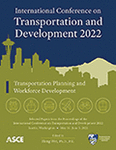A Comparative Analysis of Innovative Interchanges: Single Point Interchange, Displaced Left-Turn Interchange, and Diverging Diamond Interchange
Publication: International Conference on Transportation and Development 2022
ABSTRACT
Innovative interchange designs have been considered as an effective solution for increasing traffic demand all over the United States. However, innovative interchange designs have only gained interests from transportation management agencies in the last couple of decades, and therefore research related to innovative interchanges are scarce compared to that of intersections and other transportation assets. To examine the effectiveness and weaknesses of innovative interchanges, this study compares the operations of traditional diamond interchange with three innovative interchanges: single point interchange, diverging diamond interchange, and displaced left-turn interchange. Under the same traffic condition and similar design capacity, results indicate that innovative interchanges outperform traditional diamond interchange in all scenarios when comparing their level of service. Furthermore, the single point interchange provides outstanding operational performance compared to other interchanges. Results also show a considerable advantage of the single point interchange, which is the ability to provide balanced delays among the approaches of the interchange.
Get full access to this article
View all available purchase options and get full access to this chapter.
REFERENCES
Abdelrahman, A. (2020). Safety Evaluation of Innovative Intersection Designs: Diverging Diamond Interchanges and Displaced Left-turn Intersections, Electronic Theses and Dissertations.
Autey, J., T. Sayed, and M. Elesawey. (2013). Operational performance comparison of four unconventional intersection designs using micro-simulation. Journal of Advanced Transportation. 47. https://doi.org/10.1002/atr.181.
Bared, J. (2009). Displaced left-turn Interchange. FHWA, US Department of Transportation. https://www.fhwa.dot.gov/publications/research/safety/09056/index.cfm.
Bared, J., P. Edara, and R. Jagannathan. (2005). Design and Operational Performance of Double Crossover Intersection and Diverging Diamond Interchange. Transportation Research Record: Journal of Transportation Research Board. 1912. 31–38. https://doi.org/10.3141/1912-04.
Chlewicki, G. (2003). Interchange and Intersection Designs: The Synchronized Split-Phasing Intersection and the Diverging Diamond Interchange. Presented at 2nd Urban Street Symposium, California. https://nacto.org/docs/usdg/new_interchange_and_intersection_designs_chlewicki.pdf.
Diaz, D. M. V., B. C. Rios, A. M. F. Medina, J. C. R. Ortiz, L. M. B. Lorenzo, M. X. R. Ibarra, and E. M. C. Torres. (2019). Framework for Considering a Diverging Diamond Interchange to Improve Operations and Safety. Presented at the 17th LACCEI International Multi-Conference for Engineering, Education, and Technology: Industry, Innovation, and Infrastructure Sustainable Cities and Communities., Jamaica.
Elesawey, M., and T. Sayed. (2012). Analysis of unconventional arterial intersection designs (UAIDs): State-of-the-art methodologies and future research directions. Transportmetrica, 149. 1–36. https://doi.org/10.1080/18128602.2012.672344.
HCM 2010: Highway Capacity Manual. (2010). Washington, D.C.: Transportation Research Board.
FHWA (Federal Highway Administration). (2017). Displaced Left-Turn Interchange. US Department of Transportation/Federal Highway Administration. Retrieved January 25, 2022, from https://www.fhwa.dot.gov/publications/research/safety/09056/index.cfm.
FHWA (Federal Highway Administration). (2020). Safety.fhwa.dot.gov. Diverging Diamond Interchange. Retrieved January 25, 2022, from https://safety.fhwa.dot.gov/intersection/crossover/fhwasa14039.pdf.
Hummer, J. (2014). An Analysis of New Service Interchange Designs. International Journal of Civil, Environmental, Structural, Construction and Architechtural Engineering. South Africa. https://doi.org/10.5281/zenodo.1096604.
Hummer, J., T. Sayed, and M. Elesawey. (2009). Alternative Intersections/Interchanges: Informational Report (AIIR). FHWA, US Department of Transportaion.
Jones, E., and M. Selinger. (2003). Comparison of Operations of Single-Point and Tight Urban Diamond Interchanges. Transportation Research Record: Journal of Transportation Research Board. 1847. 29–35. https://doi.org/10.3141/1847-04 6.
Jagannathan, R. (2007). Synthesis of the median U-turn intersection treatment, safety, and operational benefits. FHWA, US Department of Transportaion.
Muchlisin, M. (2019). Modelling an Unconventional Intersection Single-point Urban interchange with PTV.VISSIM. Thrid International Conference on Sustainable Innovation 2019-Technology and Engineering., pp. 138–142. Atlantic Press. https://www.atlantis-press.com/proceedings/icosite-19/125919779 8.
Reid, J. D., and J. E. Hummer. (2001). Travel Time Comparisons Between Seven Unconventional Arterial Intersection Designs. Transportation Research Record: Journal of Transportation Research Board. 1751, pp. 56–66.
Rodegerdts, L. A., B. L. Nevers, B. Robinson, J. Ringert, P. Koonce, J. Bansen, T. Nguyen, J. McGill, D. Stewart, J. Suggett, and T. Neuman. (2004). Signalized Intersections: Informational Guide. FHWA, US Department of Transportaion.
Ramadhan, R. (2019). Comparison of Single Point Urban Interchange and Diverging Diamond Interchange Through Simulation. Diss. University of Dayton.
Schroeder, B., C. Cunningham, B. Ray, A. Daleiden, P. Jenior, and J. Knudsen. (2014). Diverging Diamond Interchange Informational Guide. FHWA, US Department of Transportation.
Tarko, A. P., M. A. Romero, and A. Sultana. (2017). Performance of alternative diamond interchange forms: Volume 2—Guidelines for selecting alternative diamond interchanges. West Lafayette. https://doi.org/10.5703/1288284316386.
Camille Thomason, P. E. (2020). “Section 6: Freeways.” Roadway Design Manual: Freeways, 1 July 2020, onlinemanuals.txdot.gov/txdotmanuals/rdw/freeways.htm.
Trafficware, Ltd. (2011). Trafficware Traffic Signal Software-User Guide. Sugarland.
Yue, R., G. Yang, X. Tian, H. Xu, D. Lin, and A. Wang. (2019). Microsimulation Analysis of Traffic Operations at Two Diamond Interchange Types. Journal of Advanced Trasportaion. https://www.hindawi.com/journals/jat/2019/6863480/.
Information & Authors
Information
Published In
History
Published online: Aug 31, 2022
Authors
Metrics & Citations
Metrics
Citations
Download citation
If you have the appropriate software installed, you can download article citation data to the citation manager of your choice. Simply select your manager software from the list below and click Download.
